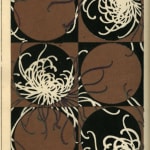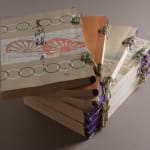







Bijutsukai (set), 1896 - 1911
Bound collection of woodblock prints on paper
9-1/4”h x 6-1/4”w
complete set 14 volumes bound in two portfolios with bone clasps.
Further images
-
(View a larger image of thumbnail 1
)

-
(View a larger image of thumbnail 2
)

-
(View a larger image of thumbnail 3
)

-
(View a larger image of thumbnail 4
)

-
(View a larger image of thumbnail 5
)

-
(View a larger image of thumbnail 6
)

-
(View a larger image of thumbnail 7
)

-
(View a larger image of thumbnail 8
)

ZUANCHO is the Japanese name for design books that were used in Kyoto’s textile industry around 1890 to 1940. The word zu-an-cho consists of three Japanese kanji characters: ZU (...
ZUANCHO is the Japanese name for design books that were used in Kyoto’s textile industry around 1890 to 1940. The word zu-an-cho consists of three Japanese kanji characters:
ZU ( design or drawing) 図+ AN (idea)案+ CHO帳 = Book of Design Ideas.
Kimono dealers, their clients, and the craftsmen who dyed, wove, embroidered the textile, and sewed the garments used zuancho to communicate with each other when they made a custom-made kimono.
The richness of these books came from being at the nexus of a heightened aesthetic common to everyone involved in kimono production and consumption customers, dealers, designers, artisans, and the publishers of zuancho themselves. During a few short decades of this time, the Kyoto culture created this convergence of client expectations and master artisans' craftsmanship. The situation has a fascinating similarity with the design world of today.
ZU ( design or drawing) 図+ AN (idea)案+ CHO帳 = Book of Design Ideas.
Kimono dealers, their clients, and the craftsmen who dyed, wove, embroidered the textile, and sewed the garments used zuancho to communicate with each other when they made a custom-made kimono.
The richness of these books came from being at the nexus of a heightened aesthetic common to everyone involved in kimono production and consumption customers, dealers, designers, artisans, and the publishers of zuancho themselves. During a few short decades of this time, the Kyoto culture created this convergence of client expectations and master artisans' craftsmanship. The situation has a fascinating similarity with the design world of today.
Signup for our Newsletter
You will receive two emails a month from us. One introduces artworks and design works from Kyoto's hidden sources and the other is stories from Misako, sharing insights into Japanese culture.
* denotes required fields
为了回应您的查询,我们将根据我们的隐私政策处理您提供的个人数据。